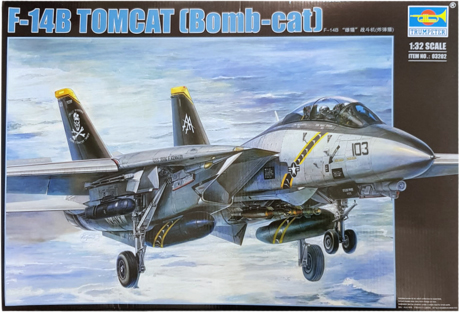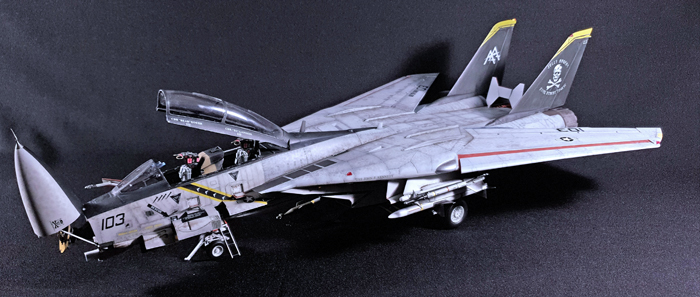
Feature Article with Kevin Ottens
Kit Nr. 03202
Grumman F-14B Tomcat (Bombcat)
A note from Geoff C…
You may remember seeing Kevin’s superb Revell Leopard 2A6NL build? If not take a look when you get a chance, and now he turns his attention to the mighty 1:32 Grumman F-14B Tomcat from Trumpeter – here’s a sneak peek at how it all turned out…

Over to you Kevin…
Intro…
Kevin Ottens switches from his usual AFVs tanks and crawled out of his comfort zone to build a massive 1:32 F-14
Maverick: “I feel the need …”
A friend of mine fell in love with the Tomcat ever since the first Top Gun movie. Knowing I have a passion for modelling, he asked me if I could build a Tomcat for him. Sure.. No problem.. Never built one, so I will give it a try. A 1:72 would be a walk in the park, a 1:48 would be more challenging, but he wanted a 1:32 model!!! I let him take a look at a variety of F-14s and he really liked the colour scheme and decals on the F-14B Tomcat from Trumpeter, kit nr. 03202. I recoiled a bit when he wanted the Trumpy kit, but all and all, it wasn’t that bad! I even managed to apply some PE material designed for the Tamiya kit.
History and technique
The Grumman F-14 Tomcat is an American supersonic, twin-engine, two-seat, twin-tail, variable-sweep wing fighter aircraft. The Tomcat was developed for the United States Navy’s Naval Fighter Experimental (VFX) program after the collapse of the F-111B project. The F-14 was the first of the American Teen Series fighters, which were designed incorporating air combat experience against MiG fighters during the Vietnam War.
The F-14 first flew on 21 December 1970 and made its first deployment in 1974 with the U.S. Navy aboard USS Enterprise (CVN-65), replacing the McDonnell Douglas F-4 Phantom II. The F-14 served as the U.S. Navy’s primary maritime air superiority fighter, fleet defence interceptor, and tactical aerial reconnaissance platform into the 2000s. The Low Altitude Navigation and Targeting Infrared for Night (LANTIRN) pod system was added in the 1990s and the Tomcat began performing precision ground-attack missions.
The F-14 received its first of many major upgrades in March 1987 with the F-14A Plus (or F-14A+). The F-14A’s TF30 engine was replaced with the improved GE F110-GE-400 engine. The F-14A+ also received the state-of-the-art ALR-67 Radar Homing and Warning (RHAW) system. Much of the avionics components, as well as the AWG-9 radar, were retained. The F-14A+ was later re-designated F-14B on 1 May 1991. A total of 38 new aircraft were manufactured and 48 F-14A were upgraded into B variants.
The TF30 had been plagued from the start with susceptibility to compressor stalls at high AoA and during rapid throttle transients or above 30,000 ft (9,100 m).[citation needed] The F110-400 engine provided a significant increase in thrust, producing 23,400 lbf (104 kN) with afterburner at sea level, which rose to 30,200 lbf (134 kN) at Mach 0.9.[94] The increased thrust gave the Tomcat a better than 1:1 thrust-to-weight ratio at low fuel quantities. The basic engine thrust without afterburner was powerful enough for carrier launches, further increasing safety. Another benefit was allowing the Tomcat to cruise comfortably above 30,000 ft (9,100 m), which increased its range and survivability.[citation needed] The F-14B arrived in time to participate in Desert Storm.
In the late 1990s, 67 F-14Bs were upgraded to extend airframe life and improve offensive and defensive avionics systems. The modified aircraft became known as F-14B Upgrade* source – Wikipedia